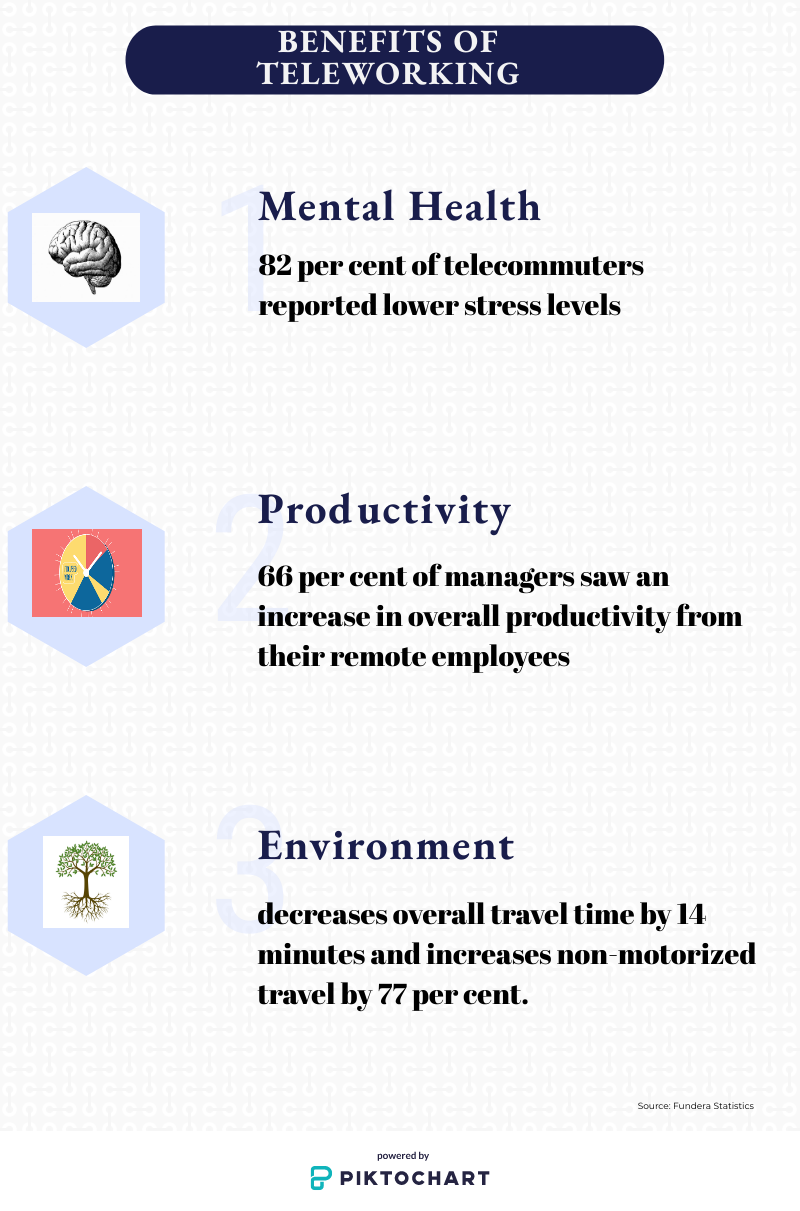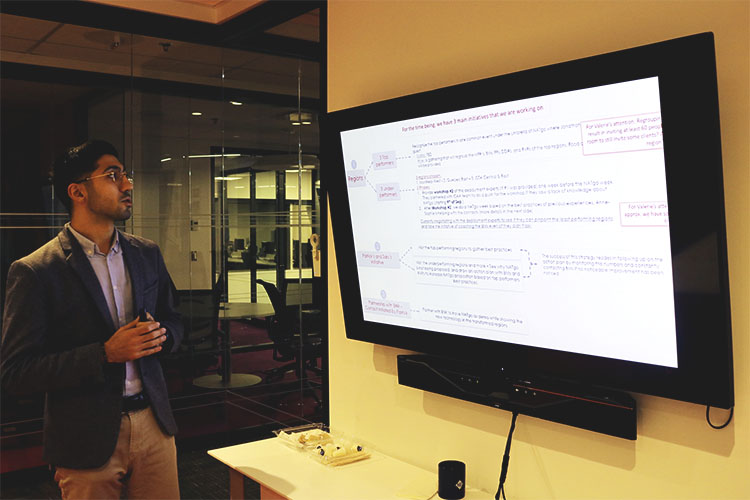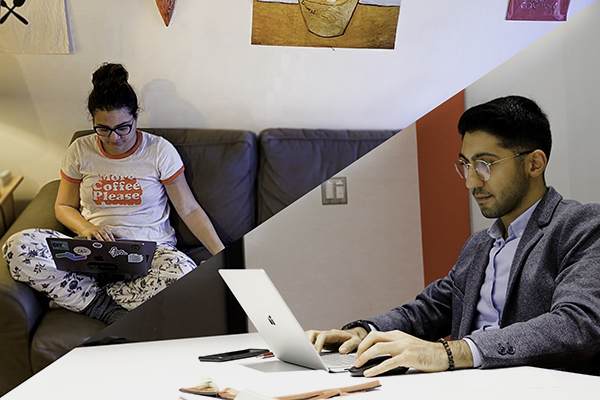BY Virginie Ann & Fatima Dia
When Ali Fares left Montreal for Boston for a few months, he left his office behind. But his work at the National Bank follows him wherever he goes.
“When I work remotely, from home or it doesn’t matter where I am, it’s the same,” says Fares. “We have a secured network and each individual has to log in through it and then you have access to your emails and files.”
Fares, 34, has been working at the bank as its senior director of investment for the past four years. He knew his employer would support him pursuing a degree in management, even helping him to do his work while he studied in Boston by allowing him to do it remotely.
Flexible schedules are also popular with a new generation of employees. The portrait of someone commuting back and forth every morning in jammed traffic and working nine-to-five in a cubicle may be the classic depiction of a day at work, but it no longer applies to a lot of workers.

Ali Fares plays with daughter Mila, as his wife Nora holds her, during his break from working at their home, on St-Denis St. in Montreal. Photo by Fatima Dia.
Teleworking is no longer an unusual option. Fares believes it should be standard.
“It wouldn’t have been possible 30 years ago,” he says. “We didn’t have technology and computers, we didn’t have those options. But now we do. I’m staying connected [through teleworking] by having a means of communication with the bank, via my laptop and my cellphone, to be able to answer emails and phone calls.”
Micheal O’Leary, the regional vice-president for Robert Half International agrees. He’s been working for the professional staffing and consulting services firm for the past 25 years, but he has only seen a real change in the five past years.
“With computers and all the online collaboration tools, it has become easier for employers to offer significant flexibility and allowing people to work from home,” he says.
What seems like an ultimate dream for some – working from home in your sweatpants, anyone? – is becoming more and more accessible. And it all comes down to cloud computing.
Cloud computing allows businesses a lot more flexibility by providing servers, storage, databases, networking, software, analytics, and intelligence—all over the internet to make teleworking possible.

Nora Ali breastfeeds her daughter Mila at her home on St-Denis St. in Montreal. Photo by Fatima Dia.
“There is definitely a market demand from candidates for more flexibility,” says O’Leary. “When everyone is well-equipped and follows a structure, we see more employees that are satisfied, who found their job more rewarding, more flexible and even become more productive in these environments.”
A study from Robert Half International shows that 61 per cent of employees use teleworking when the option is offered.
Fundera statistics show that more than two-thirds of managers saw an increase in overall productivity from their remote employees while 82 per cent of telecommuters reported lower stress levels. According to O’Leary, the demand for teleworking coincided with the arrival of Millennials in the workplace.

These are the benefits from teleworking according to the studies mentioned above. Infographic by Virginie Ann.
“Each generation has different demands, facing different challenges,” says O’Leary. “When it comes to Millenials and work environment, rapidity, flexibility, opportunities to be involved in a higher decision-level; those are all major expectations from the new generation of workers.”

Sary Rizk, 26, works at his computer at the National Bank of Canada office, on Beaver Hall Hill, Montreal. Photo by Fatima Dia.
“A lot of businesses need to adapt their way of managing their employees and how their tasks are asked to be delivered,” says O’Leary. “It actually makes managing harder as they need to make sure to have more ways to contact their employees, but there’s also a lot of tools now for better communication.”
A Comparison between Nora Ali, who works from home, and Sary Rizk, who works from the office, in reference to teleworking. Video by Fatima Dia.
Camille Landry switched from planning corporate events to coordinating the backstages and catering of summer festivals. She is happy that her new job is all about what she does, not when she does it.
“I used to work at a place where my boss wanted me to arrive at a certain hour – and leave at a certain hour to control his employees,” says Landry. “I tried having a conversation with him to explain how starting my day at 8 a.m. was making me unproductive, but he was never able to trust I could perform on my own terms. I think he was stuck in an old leadership model, where controlling the schedule reassured him.”
Three years ago, when she started to work for Équipe Spectra – which produces major events such as the Jazz Festival – she was happy that her employer trusted her with her own schedule and gave her the option of teleworking. This year, she will be starting the first few weeks of her contract not from the comfort of her home, but from Australia. As a work advantage, it doesn’t get better than this, according to Landry.
“They gave me clear objectives to reach, but then let me work at my own pace,” she explains. “I’ve been way happier since having this liberty, and my motivation to perform is way bigger now that I don’t want to lose this privilege.”
Yet, most employers still think of the concept of teleworking as being unorthodox. In fact, only 43 per cent of Canadian businesses offer the option.
O’Leary acknowledges that employers might still be reluctant to provide the option because they fear it will add technology costs and reduce productivity.

Sary Rizk, 26, gives a presentation on strategies at the National Bank of Canada, on Beaver Hall Hill in Montreal. Photo by Fatima Dia.
The low percentage of workplace currently offering teleworking can also be explained by the level of risks it generates. The corporate responsibility to protect their data – but also in some cases, their clients – becomes greater when stepping outside of the traditional work model.
“Not all employers are safely equipped,” explains O’Leary. “You need powerful tools and a secure network to safely offer teleworking to your employees without putting the company at risk.”
The Canadian Centre for Cyber Security warns organizations of the risks of having remote connections being exploited by hackers, if not properly protected.
“We see a lot of situations where personal information is leaked,” continues O’Leary. “This could be very dangerous and hurtful for a business.”
Securing data takes more than setting firewalls and Virtual Private Networks. An analysis by the Department of Computing and Information Systems of the University of Melbourne found that teleworking does increase the risk of information being leaked.
Yet technology exists to protect teleworking, such as Mozy Enterprise or QuickBooks, two of the strongest encryption applications.
“Overall, if you trust your team and employee and the right technology and self-discipline, teleworking is a great way to deliver while having the flexibility to take care of personal things at the same time,” says Fares.




